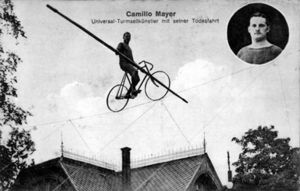Difference between revisions of "Main Page"
From Circopedia
| Line 30: | Line 30: | ||
===CAMILIO MAYER=== | ===CAMILIO MAYER=== | ||
| − | [[File:Camilio_Mayer.jpg|right| | + | [[File:Camilio_Mayer.jpg|right|300px]]Insofar as high wire artists go, the most widely known are perhaps [[The Wallendas]]. Yet, even if the original troupe of Karl and Herman Wallenda, Helen Kreis, and Joe Geiger, presented one of the best high wire acts in the business between the two World Wars and in the two decades following WWII, they belonged to a generation that had been particularly rich in outstanding German high-wire artists—among whom the most notable were undoubtedly the [[Triska Family]], and ''The Napoléon of The Skies'', Camilio Mayer. |
Camilio Mayer (1890-1972) is sometimes referred to as a French wirewalker, since his German citizenship was only the result of political circumstances: He was born April 25, 1890 in what was then Mülhausen (today Mulhouse) in Alsace, which had become part of the German Empire after the defeat of France in the Franco-Prussian war of 1870-71. However, to the French, Alsace was a region that never ceased to be French, and was due to return sooner or later to the motherland—and French-born Alsatians continued to consider themselves French, ethnically at the very least. (Indeed, Alasce returned to France after the signature of the Treaty of Versailles in 1919.).... ([[Camilio Mayer|more...]]) | Camilio Mayer (1890-1972) is sometimes referred to as a French wirewalker, since his German citizenship was only the result of political circumstances: He was born April 25, 1890 in what was then Mülhausen (today Mulhouse) in Alsace, which had become part of the German Empire after the defeat of France in the Franco-Prussian war of 1870-71. However, to the French, Alsace was a region that never ceased to be French, and was due to return sooner or later to the motherland—and French-born Alsatians continued to consider themselves French, ethnically at the very least. (Indeed, Alasce returned to France after the signature of the Treaty of Versailles in 1919.).... ([[Camilio Mayer|more...]]) | ||
Revision as of 03:51, 1 June 2013
|
In The Spotlight
CAMILIO MAYER
Insofar as high wireA tight, heavy metallic cable placed high above the ground, on which wire walkers do crossings and various acrobatic exercises. Not to be confused with a tight wire. artists go, the most widely known are perhaps The Wallendas. Yet, even if the original troupe of Karl and Herman Wallenda, Helen Kreis, and Joe Geiger, presented one of the best high wireA tight, heavy metallic cable placed high above the ground, on which wire walkers do crossings and various acrobatic exercises. Not to be confused with a tight wire. acts in the business between the two World Wars and in the two decades following WWII, they belonged to a generation that had been particularly rich in outstanding German high-wire artists—among whom the most notable were undoubtedly the Triska Family, and The Napoléon of The Skies, Camilio Mayer.Camilio Mayer (1890-1972) is sometimes referred to as a French wirewalker, since his German citizenship was only the result of political circumstances: He was born April 25, 1890 in what was then Mülhausen (today Mulhouse) in Alsace, which had become part of the German Empire after the defeat of France in the Franco-Prussian war of 1870-71. However, to the French, Alsace was a region that never ceased to be French, and was due to return sooner or later to the motherland—and French-born Alsatians continued to consider themselves French, ethnically at the very least. (Indeed, Alasce returned to France after the signature of the Treaty of Versailles in 1919.).... (more...)
New Biographies
- Walter Galetti, Clown
- Circus Williams, History
- Dosov Troupe, Teeterboard
- Camilio Mayer, High Wire Artist
- James Washington Myers, Circus Owner
New Videos
- The Chen Brothers, Hand-to-Hand Balancing (1987)
- Galetti, Bouncing Rope Act (1973)
- Camilla Mayer (Ruth Hempel), High Wire (1948)
- Louis & Franco Knie, Elephant Act (1973)
- Franco, Louis, Frédy, Erika & Mary-José Knie, High School Act (1973)
Featured Oral Histories
- Alberto Zoppé, Equestrian - Interview (McCutcheon & Distasio, 2003)
- Olivier Taquin, Mime - Interview (Jando, 2008)
- Barry Lubin, Clown (Grandma) - Interview (Jando, 2008)
- Fumagalli, Clown - Interview (Jando, 2008)
- Kris Kremo, Juggler - Interview (Jando, 2007)
A Message from the Editor
- CIRCOPEDIA is a constantly evolving and expanding encyclopedia of the international circus. New videos, biographies, essays, and documents are added to the site on a weekly—and sometimes daily—basis. So keep visiting us: even if today you don't find what you're looking for, it may well be here tomorrow! And if you are a serious circus scholar and spot a factual or historical inaccuracy, do not hesitate to contact us: we will definitely consider your remarks and suggestions.
- Dominique Jando
- Editor/Curator
